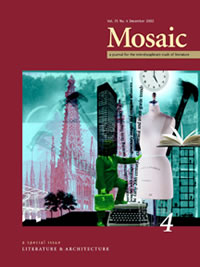Issue 35.4
Overview

Special Issue: Literature and Architecture
Published: December 2002
View the issue introduction or see the issue summary and contents below.
13 essays, totalling 256 pages
$17.95 CAD
This special issue of Mosaic includes twelve essays and an interview that engage a range of topics related to the interdisciplinary relations between literature and architecture. The issue’s opening interview with renowned architect Álvaro Siza is balanced by the closing essay, an abridged version of a lecture by Michael Benedikt delivered in October 2001 to the Faculty of Architecture at the University of Manitoba. The essays in this issue compare poetic form to architecture, architecture as poetry, the metaphor of architecture, and a range of literary and architectural genres and periods.
An Interview with Álvaro SizaDawne McCance In Portugal, where it seems that everyone you meet speaks knowledgeably and proudly of his work, he is called by his full name, Alvro Siza Vieira. He is, of course, that country’s most famous architect, and, in keeping with the crossing of local and global that has marked his entire career, he is also internationally renowned, and a recipient of, among many other awards, the Pritzker Architecture Prize. Mosaic sought out Siza for this special issue because he is both architect and artist: according to what he says, and what he builds, literature and architecture belong inseparably together. The following interview took place on 17 May 2002 in Siza’s Rua Do Aleixo office in Oporto, Portugal. | |
Reading the “Remembered World”: Carceral Architecture and Cultural Mnemonics in Peter Carey’s IllywhackerCliff Lobe This essay explores linkages between architecture and memory in the context of Australia’s penal-colonial past and postcolonial present. Examining how built spaces “house” the past, the essay reads the carceral architecture in Peter Carey’s Illywhacker as a counter-memory, a haunting reminder that the edifice of Australia has been built on (cryptic) lies. | |
Electricity, Writing, ArchitectureAndrew Leach This essay examines Francis Ponge’s 1954 “Texte sur l’électricité” as an example of interdisciplinary interaction. The writer sits between electrician and architect as a technical translator; his response to this circumstance provokes a discussion of the role of “technique” in specifically framed modern discourses. | |
Building a Better Metaphor: Architecture and Russian Production NovelsMary A. Nicholas The Russian production novel, featuring construction of factories, bridges, and socialist skyscrapers, was a Soviet favourite of the late 1920s and 1930s. This essay rejects the binary model commonly applied to the period and argues for a revised theoretical approach to the genre. | |
The Hidden Rooms of Isabella Valancy Crawford and P.K. PageWanda Campbell The discursive triangle—architecture, feminist theory, creative texts—enhances our understanding of the architecture of the female imagination. This essay applies reflections on gender and space to two Canadian poems with the same title written more than a century apart. | |
The Narrative Limits of the Global GuggenheimDina Smith Focussing on the recent exhibition of artist Marjetica Potrc, this essay relates the Guggenheim New York and the Guggenheim Bilbao to theories of globalization, asking how globalizing processes have influenced the arts. | |
Where Do You Think You Are? Alice Munro’s Open HousesRobert McGill Alice Munro’s “Vandals” invites critical readings of geography and space in her work. Her evocation of the house as a metonym for fiction challenges the privileging, by spatial theorists, of mobility and deterritorialization. | |
Diagnosing the “Sir Walter Disease”: American Architecture in the Age of Romantic LiteratureKerry Dean Carso This essay argues that Gothic literature and historical romances changed the course of American architecture by influencing architect Alexander Jackson Davis (1803-1892). Davis’s client Robert Gilmor III shared his love of Gothic fiction and even visited Scott’s Abbotsford and Walpole’s Strawberry Hill before commissioning Davis to design Glen Ellen (1832-1833). | |
“The Frayed Trope of Rome”: Poetic Architecture in Robert Duncan, Ronald Johnson, and Lisa RobertsonStephen Collis This paper argues that literary architecture gives expression to poetry’s social and utopian desires and that, in this, the architectural rises above the metaphorical, becoming a central aspect of twentieth-century avant-garde poetics and its attempts to embody public space. | |
Concretizing the 1970s in Hodges’s Get Carter and Torrington’s Swing Hammer Swing!Peter Clandfield and Christian Lloyd While architectural modernism aims to manage space objectively, literary and cinematic modernisms often defend subjective, user-adaptable space. Drawing on Mikhail Bakhtin’s theory of chronotope (time-space) and Raymond William’s theory of class, this essay shows how the disjunction between modernisms is concretized in two British representations of urban redevelopment. | |
Gothic Architecture in the Poetry of David Jones and Geoffrey HillPaul Robichaud The complex relationship between ethics and aesthetics shapes the historical analyses offered in the poetry of David Jones and Geoffrey Hill. This essay examines the symbolic, historical, and formal significance of Gothic architecture in their poetry, showing how it illustrates their very different explorations of aesthetic value. | |
Gaudí’s Architecture: A Poetic FormEsther Raventós-Pons How does architecture construct meaning? Is architecture a visual language? In this essay, Antoni Gaudí’s architecture is examined as poetic discourse. | |
Thinking Toward ArchitectureMichael Benedikt The following is a condensed and abbreviated version of a lecture that Michael Benedikt delivered to the Faculty of Architecture at the University of Manitoba on 21 October 2001 |